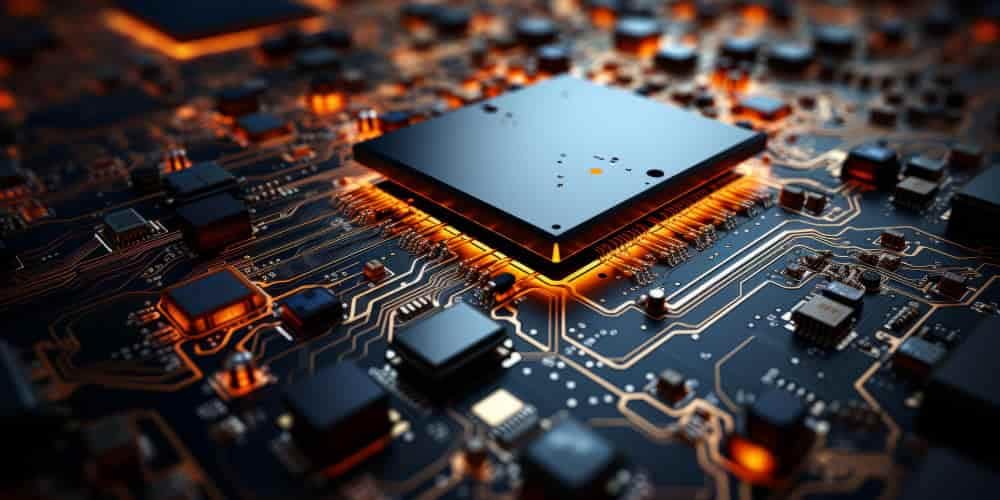As we move forward to 2024, we are entering an exciting time of innovation and technological change. Technology trends are evolving unprecedentedly, transforming how we live, work, and interact with the world. This article will explore the main technology trends for 2024 that will be shaping our immediate future.
Cybersecurity is a crucial issue in today's digital age and one of the main technological trends for 2024. A growing number of services and activities depend on digital technology and internet connectivity. Cybersecurity is dedicated to safeguarding information, systems, and networks against possible attacks, threats, or vulnerabilities that may risk their integrity, confidentiality, or availability.
According to studies and analysis, cybersecurity predicts an increase in the number and complexity of cyberattacks. There will also be an increase in demand and investment in security solutions. Some of the technological trends for 2024 in terms of cybersecurity are:
Generative Artificial Intelligence: refers to the ability to generate content, designs, products, or services using artificial intelligence models. These are trained with large volumes of data and accessible through the cloud and open source. Generative Artificial Intelligence can have beneficial applications for security. Some of these benefits are the generation of secure passwords, the detection of anomalies, or the simulation of attack scenarios. However, it can also have harmful applications, such as generating malware, phishing, deepfakes or spoofing.
Adaptive cybersecurity involves using artificial Intelligence, machine learning, and automation. This technology helps us detect, prevent and respond to cyberattacks dynamically and proactively. It also adapts to the context and user behavior. It also improves the effectiveness, efficiency, and resilience of security systems and reduces costs and associated risks.

Adaptive cybersecurity involves using artificial Intelligence, machine learning, and automation. This technology helps us detect, prevent and respond to cyberattacks dynamically and proactively. It also adapts to the context and user behavior. It also improves the effectiveness, efficiency, and resilience of security systems and reduces costs and associated risks.
Security and privacy in hybrid cloud and edge computing: refers to using advanced security and privacy solutions. This advance protects data in the hybrid cloud and edge computing, such as encryption, authentication, confidential computing, or blockchain. These solutions ensure the integrity, confidentiality, and availability of data. They also help to comply with the regulations and standards of each sector and region.
Cybersecurity with a focus on senior management: This technological trend for 2024 refers to the need for senior managers of organizations to be involved in cyber risk management. These can affect their operation, reputation, and competitiveness. Senior managers must have a strategic vision, a security culture, and a CISO (Chief Information Security Officer) role. This advance can support and guide them in making decisions about cybersecurity.
AI will be one of the leading technological trends by 2024. This year, it has captured the attention of everyone inside and outside the technology sector. The new year will be the perfect setting to continue presenting innovations.
Democratized generative AI: It is a type of Artificial Intelligence (AI) that can create new content, such as conversations, stories, images, videos, and music from existing data. These technological trends in 2024 will be democratized thanks to the combination of massively pre-trained models. Cloud computing and open source make these models easier to obtain and apply. By 2026, at least 80% of companies will have used generative AI models. In 2023, they were less than 5%.
"Custobots," Also called "customer machines," are personalized robots that can interact with customers naturally, empathetically, and effectively. The "Custobots" will be able to recognize the faces, voices, and moods of customers and adapt to their preferences and needs. Some examples of "custombots" are customer service, delivery, entertainment, and personal care robots. As part of the technology trends for 2024, millions of connected products are expected to have the potential to behave like customers. This technological trend will grow in the coming years and will generate millions of dollars in income.

Intelligent applications: These are those that include Artificial Intelligence capabilities and integrate connected data from transactions and external sources to obtain a better service. Intelligent applications will be able to understand users' context, preferences, and emotions and anticipate their needs and behaviors. Some examples of intelligent applications are health, education, entertainment, e-commerce, and social networks. AI will be the technological trend by 2024, with the most significant impact on companies worldwide. This is expected to extend to the next three years.
AI platforms will increasingly combat content generated by the imagination of different models. The generative AI models themselves will be combined with high-quality information from Knowledge Graphs.
Generative AI can contribute to sustainability and social well-being, generating creative solutions to global problems and delivering enriching experiences for people and businesses worldwide.
Quantum technology is one of the most promising and revolutionary areas of science and engineering. It exploits the properties of subatomic particles to perform operations that exceed the limits of classical computing. As part of the technological trends for 2024, according to a report by the consulting firm McKinsey, the global quantum technology market could reach $65 billion in 2030. It is indicating an annual growth of 16%.
Quantum measurement and detection devices: These quantum devices take advantage of the characteristics of subatomic particles to make physical measurements. They have precision and sensitivity that surpass conventional devices. These technological trends in 2024 will experience significant improvements, including size, cost, and energy consumption reductions. You will also see the expansion of its operating range and its resistance to environmental noise.

Quantum cloud computing: Companies such as IBM, Google, Microsoft, and Amazon already offer quantum computing services in the cloud. By 2024, the supply and demand for this type of service is expected to expand. Quantum cloud computing will facilitate the development of quantum applications, professional training, and scientific research.
In the United States, the entity known as the National Institute of Standards and Technology will announce guidelines for "post-quantum cryptography" (PQC) in 2024. This is understood as encryption algorithms that are considered to be immune to quantum incursions. Considering that the Quantum Computing Cybersecurity Readiness Act requires that public and private entities that supply the US government be ready to transition to PQC within one year of the disclosure of the NIST regulations, This issue may feature prominently in boardroom discussions in 2024.
As part of the technological trends of 2024, digital trust ecosystems are expected to become an essential element. They will be present in any commercial or business activity in the digital field. Digital trust will become crucial for creating value, consolidating reputation and competitiveness, and opening new avenues for growth and innovation. Digital trust ecosystems are expected to be significant in various applications in the coming year.
Sovereign digital identity: By 2024, the Sovereign Digital Identity (SSI) is expected to evolve significantly. SSI is intended to allow us to own our information, eliminating the need for intermediaries. Biometrics are expected to transform how we interact with digital systems. This is one of the most notable advancements, providing unprecedented user convenience and security challenges for adversaries.
The US financial sector is expected to adopt digital identity technologies to combat synthetic identity fraud. This could lead to losses of at least $23 billion by 2030. This trend promises to transform how we interact with the digital world, providing greater security, privacy, and control over our personal data.

The data economy: The data economy is expected to drive innovation and growth in various sectors. Augmented Intelligence will allow organizations to use large volumes of data more efficiently. Digital trust will be one of the technological trends in 2024 that is essential for doing business in the digital world. Compatible companies with a focus on modular business architectures will facilitate the integration of innovation in organizations.
The data economy is based on big data analytics, artificial Intelligence, cloud computing, and edge computing. These technology trends for 2024 will facilitate data analysis, processing, and distribution efficiently and at scale. In short, the data economy promises to transform how we do business and engage with the digital world by 2024.
Adaptive cybersecurity: Refers to the ability of organizations to actively and flexibly defend themselves against cyber threats. They also adjust to the environment and the actions of the users. This form of cybersecurity relies on technologies such as artificial Intelligence, machine learning, and cloud computing. These technological trends for 2024 will facilitate automated and personalized detection, prevention, and response to cyberattacks.
In 2024, humanity is preparing to return to the moon. This renewed interest in space technologies aims to boost scientific discoveries and help solve Earth's most critical challenges. An example of this would be monitoring climate risks and disasters, better access to telecommunications, and defense and sovereignty.
The new space age is driven not only by public organizations but also by private agents; these range from startups to corporations. They also support technologies such as 5G, advanced satellite systems, big data, quantum computing, etc. In 2024, this should accelerate innovation and support technological projects in the field of sustainable spacecraft propulsion and new low-Earth orbit constellations for seamless communications and quantum cryptography.

Semiconductors are the most traded goods in the world. They are a crucial factor in digital transformation and one of the most relevant technological trends for 2024. Moore's Law states that the computing power of a microchip doubles every two years, while its cost is halved. This theory is still being determined whether it is reaching its physical and economic limits. The semiconductor industry is on the verge of a transformative era, with multiple factors converging to redefine its landscape.
Chips are reaching 2nm, and transistors are approaching the size of a few atoms. Increasing investments in R&D and cutting-edge manufacturing facilities are becoming a challenge even for the largest chipmakers. 2024 should witness an evolution of Moore's Law with new paradigms. Despite approaching the absolute physical limit of chip miniaturization, chipsets should see advances in 3D chip stacking, materials science innovations, and new lithography forms. This would continue to increase computing power.

An accelerated digital transformation is expected in all sectors. More powerful connected objects, from smartphones to electric vehicles, including data centers and telecommunications, will give this possibility. These technological advances will be reflected in changes in the semiconductor ecosystem itself. They will be evident in emerging new gigafactories, regulations, business models, and foundry services in 2024.
Hybrid cloud is one of the technological trends combining public and private cloud services, taking advantage of both advantages. For next year, the hybrid cloud is expected to continue being an essential trend in the technology world. According to a report from IPM, a Ricoh Company, hybrid environments are expected to remain predominant in the future. They allow companies to benefit from the advantages of the cloud. These advantages would be scalability, flexibility, speed of deployments, business continuity, and the company's infrastructures and platforms.
Application modernization is expected to be a significant trend in the future as long as the adoption of cloud-native microservices architectures is implemented. On the other hand, the search for efficiency and costs under control is expected to continue to be a priority for companies.
Combining hybrid cloud with edge data processing will reduce latency, bandwidth consumption, and costs. It will also improve data security and privacy. In addition, it will facilitate the development of real-time applications, augmented reality, artificial Intelligence, and robotics.
Artificial Intelligence in the Hybrid Cloud: By 2024, Artificial Intelligence (AI) is expected to be driven by generative AI, AI trust, risk and security management, and AI-augmented development. Hybrid cloud adoption will remain high, with 75% of organizations implementing tools for multi-cloud data logistics. These technology trends for 2024 will drive innovation and job creation in AI.
Security and privacy in the hybrid cloud: Security and privacy in the hybrid cloud are expected to focus on data protection. Regulatory compliance, supply chain security, and developing cyber-secure codes will also be determining factors. Companies will strive to limit data exposure. Compliance with the rules will be verified in addition to effectively managing vendors' software systems and moving cybersecurity to the source of all applications.

Of the technological trends for 2024, the hybrid cloud is expected to drive automation and Industry 4.0. This is evidenced by the Internet of Things (IoT), Artificial Intelligence (AI), and robotics. IoT networks will allow real-time adaptation to events. While AI and automation will improve production efficiency. Additionally, collaborative robots will be used in tasks such as assembly and logistics, improving the efficiency and quality of operations.
Autonomous mobility and hybrid cloud combine to revolutionize transportation. This involves the use of autonomous vehicles. An example of this equipment would be drones and other means of transport that can navigate safely, efficiently, and ecologically without human intervention; The hybrid cloud powers all this. This technology will allow organizations to monitor and direct their fleets remotely and in real-time. This will open the way to new possibilities for efficiency and sustainability.
In conclusion, 2024 promises to be a year of significant technological advances. Emerging trends such as Artificial Intelligence, hybrid cloud, autonomous mobility, and cybersecurity are shaping a future where technology and digitalization will play an even more crucial role in our daily lives and the global economy. These trends are not only redefining how we interact with the digital world, they are also creating new opportunities and challenges. As we move towards this future, we must continue exploring, innovating, and adapting to these technological trends to maximize their benefits and minimize risks. 2024 will be an exciting year for technology, and we must all be prepared to embrace the opportunities that await us.

We are a company that drives digital transformation with software solutions, mobile applications, AI, automation and customized IT services.
CONTACT USCopyright © 2013- Alpes Solutions LLC. All Rights Reserved